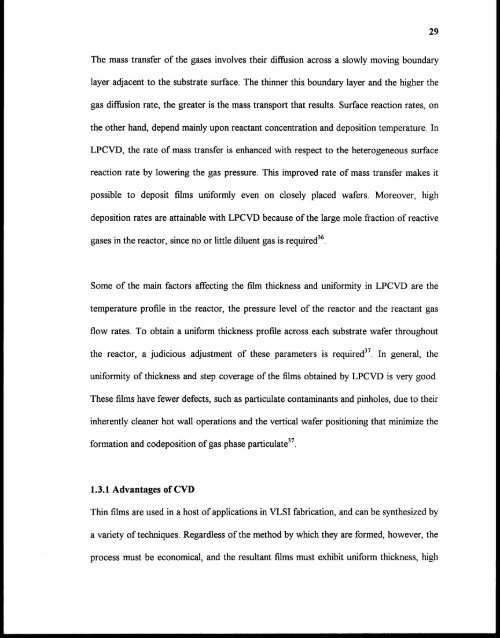njit-etd2000-029 - New Jersey Institute of Technology
njit-etd2000-029 - New Jersey Institute of Technology
njit-etd2000-029 - New Jersey Institute of Technology
You also want an ePaper? Increase the reach of your titles
YUMPU automatically turns print PDFs into web optimized ePapers that Google loves.
29<br />
The mass transfer <strong>of</strong> the gases involves their diffusion across a slowly moving boundary<br />
layer adjacent to the substrate surface. The thinner this boundary layer and the higher the<br />
gas diffusion rate, the greater is the mass transport that results. Surface reaction rates, on<br />
the other hand, depend mainly upon reactant concentration and deposition temperature. In<br />
LPCVD, the rate <strong>of</strong> mass transfer is enhanced with respect to the heterogeneous surface<br />
reaction rate by lowering the gas pressure. This improved rate <strong>of</strong> mass transfer makes it<br />
possible to deposit films uniformly even on closely placed wafers. Moreover, high<br />
deposition rates are attainable with LPCVD because <strong>of</strong> the large mole fraction <strong>of</strong> reactive<br />
gases in the reactor, since no or little diluent gas is required 36 .<br />
Some <strong>of</strong> the main factors affecting the film thickness and uniformity in LPCVD are the<br />
temperature pr<strong>of</strong>ile in the reactor, the pressure level <strong>of</strong> the reactor and the reactant gas<br />
flow rates. To obtain a uniform thickness pr<strong>of</strong>ile across each substrate wafer throughout<br />
the reactor, a judicious adjustment <strong>of</strong> these parameters is required'. In general, the<br />
uniformity <strong>of</strong> thickness and step coverage <strong>of</strong> the films obtained by LPCVD is very good.<br />
These films have fewer defects, such as particulate contaminants and pinholes, due to their<br />
inherently cleaner hot wall operations and the vertical wafer positioning that minimize the<br />
formation and codeposition <strong>of</strong> gas phase particulate".<br />
1.3.1 Advantages <strong>of</strong> CVD<br />
Thin films are used in a host <strong>of</strong> applications in VLSI fabrication, and can be synthesized by<br />
a variety <strong>of</strong> techniques. Regardless <strong>of</strong> the method by which they are formed, however, the<br />
process must be economical, and the resultant films must exhibit uniform thickness, high
















